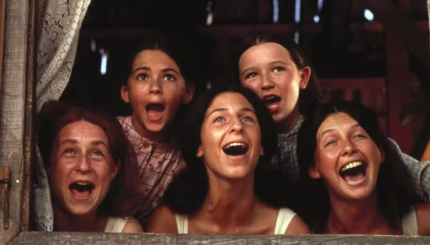Brides with Ketubah Courtesy Mark Andres
The brides were sequestered in a tiny room at the banquet hall less than an hour before their wedding, fixing their hair and makeup. They greeted me anxiously. “Just a minute,” one told me, “We’re not ready yet.” A moment later they opened the door to welcome me inside. Standing there in gorgeous cream-colored gowns, similar but not identical in design, they both looked stunning. The decades of their adult lives, successful careers and raising a wonderful son to adulthood melted away in their beauty at that moment. One of them expressed a wordless sigh, emotion written all over her face, her body momentarily tensing. With worry, I asked, “What is it?” As the tears welled up she said, “I’ve been to a lot of weddings, and dreamed of being a bride, but I never thought it would really happen. It’s so amazing!” We were ready to weep with joy.
When the happy couple walked down the aisle to the huppah, or wedding canopy, under which they would sanctify and legalize their long-term relationship, the guests jumped to their feet bursting with applause. Amid cheers, tears and immense joy and love, the brides and their son came to the huppah. The ceremony transported everyone to another dimension; when the breaking of the glass broke the spell, the guests once again rose up to cheer. It was a release of joy after years of being on the outside of society’s formula of acceptable marriages by laws that did not recognize the families created by same-sex couples.
I will carry these images to my seder next week along with many joyous celebrations with couples in the past year since same-sex marriage became legal here. I will think of this as I assemble my Seder plate, for the first time with an orange.
“An orange?” you may ask. Perhaps, like many in the progressive Jewish community, you heard the 1990’s myth that feminist leaders began to put oranges on seder plates to symbolize the need for women’s equality in Judaism. One version told that the orange symbolized the need to accept women rabbis. While both are nice stories, the actual events that led to the placement of an orange on a seder plate arose from a conversation about the exclusion of lesbians (and gays) from Jewish life and ritual. (See this great resource for the narratives.)
Years ago, after I heard the mythic meaning ascribed to the symbolic orange, I lost enthusiasm for the new ritual. Yet, every Passover I was sure to talk about it, along with the call for justice that defined it.
This year I am rethinking the orange; this year I am celebrating justice. And I am mindful to remember that LGBTQ justice is incomplete, in this country, and in the world. I invite you to join me.
Happy Passover!
Like this post? Join the conversation through MyJewishLearning’s weekly blogs newsletter.
seder
Pronounced: SAY-der, Origin: Hebrew, literally "order"; usually used to describe the ceremonial meal and telling of the Passover story on the first two nights of Passover. (In Israel, Jews have a seder only on the first night of Passover.)



